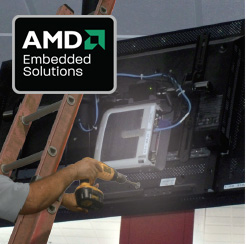- Home
- Symmetry Blog
- Why AMD Embedded - Part 2 of 9 in a Series Presented by Symmetry Electronics and SemiconductorStore.
Why AMD Embedded - Part 2 of 9 in a Series Presented by Symmetry Electronics and SemiconductorStore.com
Wednesday, February 13, 2013
The purpose of part 2 of our series is to clearly differentiate AMD's leading embedded solutions from the popular PC options of 5 or 10 years ago and recognize the dramatic evolution that is currently taking place in embedded technology. Embedded is a huge market forecasted by IDC to grow globally to $2.6 trillion in revenue by the end of 2015. Most people don’t realize that PC’s account for only around 2% of all computing devices currently in use today. According to the Artemis Embedded Computing Systems Initiative, 98% of all computing devices today are embedded into other types of electronic equipment and there will be more than 40 billion embedded devices by 2020.
So why is there still hesitation when it comes to the embedded transition? Some feel a PC has higher performance (especially in graphic and video-intensive applications) than an equivalent embedded system. This is not the case and as AMD continues to innovate and improve its current embedded products, this could not be further from the truth.
Today’s mainstream PC processing subsystems (CPU, graphics, and video) feature high MHz, multiple cores, large caches, fast and wide system busses, and while it’s true that most current PCs will beat an embedded platform in running typical PC applications and benchmarks, the question is how much performance do you really need and what kind of performance do you really need? And at what price are you willing to pay for that level of performance in terms of size and power consumption? While many of today’s embedded applications are evolving towards more interactive, connected, and multimedia-rich usage scenarios (i.e. “Intelligent Systems”), AMD’s embedded CPUs and GPUs are more than keeping pace with ever increasing performance requirements. Many devices in production today feature multiple cores, fast dedicated 2D and 3D graphics, and hardware support for multiple streams of high definition video. These AMD devices are architected to provide a level of performance targeted at specific embedded applications and highly optimized to provide superior performance per dollar and performance per watt over traditional PCs.

The operating system also plays a significant role in system performance. Today’s mainstream PCs need to have an exceptional amount of horsepower and system memory in order to efficiently run Windows® or Linux® operating systems and to be able to execute several demanding applications and background tasks concurrently. Because embedded systems typically have a predefined set of applications that they are required to run, the overall performance requirement of the hardware is typically less than for a PC, without sacrificing the user experience. A limited application set also allows an embedded system to run an operating system specifically architected for an embedded system such as Windows Embedded (and all of its variants) and Embedded Linux. While these operating systems are fully featured, they are also available as componentized packages that can be built to match the embedded hardware, meaning that the resulting “image” only contains the modules, resources, and drivers that are required to support the specific hardware configuration and limited application set. Embedded operating systems are also “thinner” meaning that applications have more direct control over and faster access to the hardware which can contribute significantly to overall system performance. Think about all the times installing a new device driver for your PC has significantly improved its performance running a specific application (especially a graphics-intensive application). This is just one example of how multiple layers of software that reside between an application and the hardware in a typical PC can affect performance and user experience.
Now that we have seen how AMD technology in an embedded platform can translate into "less is more" for graphic specific applications, we will move onto comparing the standards of PCs and the new graphics leader, AMD, in part 3 of our series.